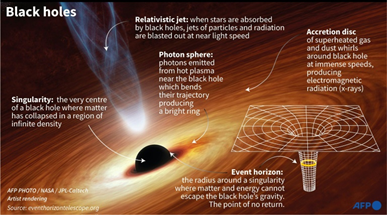

16th May 2022 (7 Topics)
Context
Astronomers of the Event Horizon Telescope (EHT) recently revealed the first photograph of Sagittarius A*, a supermassive black hole about 26,000 light years from Earth and situated at the centre of the Milky Way.
- In April 2019, astronomers captured the first ever photograph of a black hole M87, which was located in a distant galaxy called Messier 87.
About
What are black holes?
- A black hole is formed when stars collapse, leading to a space in the universe with an escape velocity — the speed at which an object must travel to override a planet or an object’s gravitational force.
- For instance, for a spacecraft to leave the surface of the Earth, it needs to be travelling at a speed of about 40,000 km per hour which is so great that even light cannot escape it.
- Because light cannot get out, black holes are invisible and can only be tracked with the help of spatial telescopes and special tools.
- The light cannot go out because the gravity inside a black hole is very strong as a result of a lot of matter being squeezed into a small space.
- In 2020, the Royal Swedish Academy of Sciences decided to award one half of the year’s Nobel Prize in physics to Roger Penrose and the other half jointly to Reinhard Genzel and Andrea Ghez for furthering the understanding of black holes, the most “enigmatic” objects in the universe.

Why and how was the blackhole photographed?
- The photograph provides evidence that the object at the centre of the Milky Way, which has been a subject of speculation for decades, is indeed a black hole.
- To take its photograph, the team created a powerful Event Horizon Telescope after which Sagittarius A was observed on multiple nights and data was collected for hours in a row, an exercise similar to using a long exposure time on a camera.
- A statement released by EHT said that scientists are excited about having images of two black holes that are of very different sizes, “which offers the opportunity to understand how they compare and contrast.”
Event Horizon Telescope:
- The EHT is an international collaboration that has formed to continue the steady long-term progress on improving the capability of Very Long Baseline Interferometry (VLBI) at short wavelengths in pursuit of this goal.
- This technique of linking radio dishes across the globe to create an Earth-sized interferometer.
- It has been used to measure the size of the emission regions of the two supermassive black holes with the largest apparent event horizons: SgrA* at the center of the Milky Way and M87 in the center of the Virgo A galaxy.

More Articles

